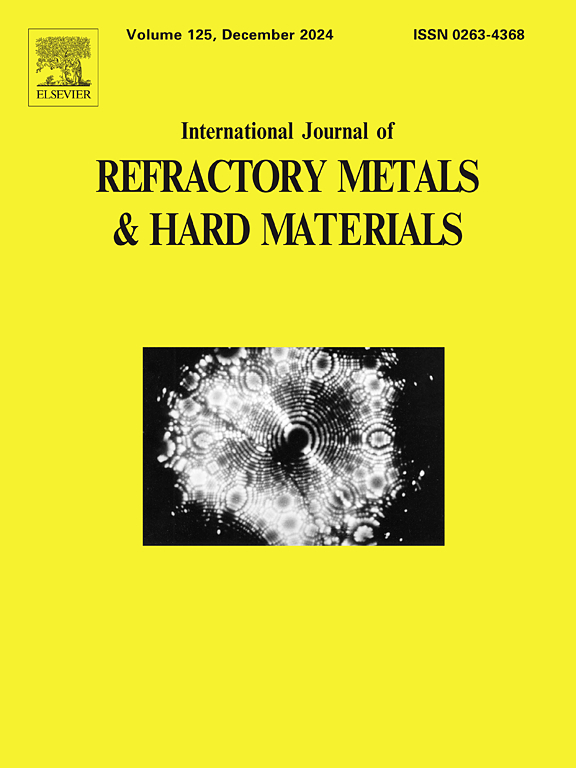不同类型残余应力wc基爆轰涂层的微观结构与性能
IF 4.2
2区 材料科学
Q2 MATERIALS SCIENCE, MULTIDISCIPLINARY
International Journal of Refractory Metals & Hard Materials
Pub Date : 2025-05-15
DOI:10.1016/j.ijrmhm.2025.107236
引用次数: 0
摘要
在CCDS2000装置上使用基于双组分燃料(aС2Н2 + bС3Н6 + cО2)的炸药混合物对WC-12Co、WC-10Co4Cr和WC-12Ni涂层进行爆轰喷涂。涂层是在碳钢基体上形成的。用于喷涂的爆轰枪管有三种不同的配置,以在涂层中产生拉伸和压缩应力以及非应力状态。研究了涂层的显微组织、硬度、附着力、磨料磨损、摩擦磨损和耐腐蚀性,以确定其与残余应力类型的关系。结果表明,具有压残余应力的涂层在滑动摩擦下的硬度和耐磨性明显高于具有拉残余应力的涂层,但在磨粒磨损下的耐磨性有所提高。即,将具有压缩残余应力的WC-12Co、WC-10Co4Cr和WC-12Ni涂层与具有拉伸残余应力的WC-12Co涂层进行比较,发现前者具有更高的硬度,分别为1.22、1.15和1.32倍,摩擦磨损损失分别为1.37、2.34和1.81倍。在盐雾环境下的腐蚀试验表明,无论其成分和残余应力类型如何,所有处于喷涂状态的涂层都以相同的方式腐蚀。由Metcoseal AP和Metcoseal APT稀释剂(3:1 v/v)组成的混合物浸渍的涂料比未浸渍的涂料具有更好的耐腐蚀性。其中,在WC-12Ni涂层中,残余压应力较高的涂层具有最高的耐蚀性。本文章由计算机程序翻译,如有差异,请以英文原文为准。
Microstructure and properties of WC-based detonation coatings with residual stresses of different types
Detonation spraying of WC-12Co, WC-10Co4Cr and WC-12Ni coatings was performed on a CCDS2000 facility using explosive mixtures based on a two-component fuel, aС2Н2 + bС3Н6 + cО2. The coatings were formed on carbon steel substrates. The detonation gun barrels used for spraying were of three different configurations to produce tensile and compressive stresses as well as an unstressed state in the coatings. Studies of the microstructure, hardness, adhesion, abrasive wear, friction wear, and corrosion resistance of the coatings were carried out in order to identify their dependence on the type of residual stresses. The results show that coatings with compressive residual stresses exhibit significantly higher hardness and wear resistance under sliding friction than coatings with tensile stresses and, although less noticeable, an increase in wear resistance under abrasive wear. Namely, when the WC-12Co, WC-10Co4Cr and WC-12Ni coatings with compressive residual stresses were compared with those with tensile stresses, the former were found to possess higher hardness by a factor of 1.22, 1.15 and 1.32, respectively, and lower friction wear losses by a factor of 1.37, 2.34 and 1.81, respectively. Corrosion tests in the salt spray environment showed that all coatings in the as-sprayed state corrode in the same manner regardless of their composition and the type of residual stresses. Coatings impregnated with a mixture consisting of Metcoseal AP and Metcoseal APT diluent (3:1 v/v) resist corrosion much better than the non-impregnated coatings. Herewith, in the case of WC-12Ni, the coating with compressive residual stresses showed the highest resistance to corrosion.
求助全文
通过发布文献求助,成功后即可免费获取论文全文。
去求助
来源期刊
CiteScore
7.00
自引率
13.90%
发文量
236
审稿时长
35 days
期刊介绍:
The International Journal of Refractory Metals and Hard Materials (IJRMHM) publishes original research articles concerned with all aspects of refractory metals and hard materials. Refractory metals are defined as metals with melting points higher than 1800 °C. These are tungsten, molybdenum, chromium, tantalum, niobium, hafnium, and rhenium, as well as many compounds and alloys based thereupon. Hard materials that are included in the scope of this journal are defined as materials with hardness values higher than 1000 kg/mm2, primarily intended for applications as manufacturing tools or wear resistant components in mechanical systems. Thus they encompass carbides, nitrides and borides of metals, and related compounds. A special focus of this journal is put on the family of hardmetals, which is also known as cemented tungsten carbide, and cermets which are based on titanium carbide and carbonitrides with or without a metal binder. Ceramics and superhard materials including diamond and cubic boron nitride may also be accepted provided the subject material is presented as hard materials as defined above.

 求助内容:
求助内容: 应助结果提醒方式:
应助结果提醒方式:


